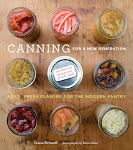Mr. Chalmers smoked huge, thick chuck roasts he rubbed with his special combination of salt, salt, salt, cayenne, dried oregano, and sliced garlic. I think he cooked them with hickory for about three and a half hours, and they were nice and tender, juicy, spicy, meaty. Chuck really is an excellent cut of meat for smoking, and I'm surprised more people don't use it instead of the more expensive brisket. The only trick is slicing it across the grain, which tends to go every which way. We've even smoked thinner chuck "steaks" with great results.
In the oven, in a (cowboy?) bain marie, we baked a simple corn pudding with roasted poblano peppers: corn, peppers, milk, heavy cream, melted butter, fresh eggs from the lady down the road, et cetera.
The night before, I soaked two pounds of Great Northern beans in water. Early the next morning, I simmered the beans in fresh water for about an hour, drained them, and added new water, some molasses, dry mustard, a little ketchup, a lot of bacon, and one and a half chopped onions. I dug a hole and started a big fire in it, and let it burn down to embers. It was cold outside, and had just begun to get light. With the Mister's help I set the Dutch oven full of beans, along with a few potatoes brushed with butter, seasoned with fresh herbs, and wrapped in foil, down in the coals and we shoveled some of the coals on top, then covered the whole thing with dirt until we couldn't see any smoke rising from the ground. I think the fire probably died when we covered it with dirt, because when we dug the pot up five hours later it was barely warm. So I put the pot on the stovetop and finished up the beans the regular way. These were New England–style beans, not Southern or Texas beans, but they were pretty rustic anyway. We put the potatoes and sweet potatoes in the coals in the smoker while the meat was cooking.
 This is the covered-up hole for the beans; we checked it every now and then to make sure we hadn't started an underground fire, though I suppose there could be one raging out there as I write and we wouldn't know about it.
This is the covered-up hole for the beans; we checked it every now and then to make sure we hadn't started an underground fire, though I suppose there could be one raging out there as I write and we wouldn't know about it.More successful was the cobbler, which we made in an eight-quart Dutch oven ("Made in China for Texsport, Houston") with a flat, rimmed lid and three legs. Apples, pears, lemon juice, sugar, cinnamon, nutmeg, and tapioca. I precooked the fruit a bit because I wasn't sure how it would work on an open fire, but as it turns out I didn't need to do that: the hardwood fire Mr. Chalmers and our friend built in the old goat-cooking pit was extremely hot, and the fruit juices were boiling in no time. As soon as it was all bubbly, Mr. Chalmers mixed up a biscuit-y topping (flour, sugar, salt, baking powder, half butter and half nonhydrogenated shortening, then milk) and dolloped it on, trying not to singe his arm. We put the lid on and piled coals on top. We let it cook like that for about twenty minutes, then I said it was time, and we pushed the coals off the pot and lifted the lid and it was perfect. A little blackened on the side closest to the center of the fire, but otherwise just right. It may well be the best cobbler I've ever had a hand in making. The apples and pears were all dark and caramelized, and somehow the topping was both fluffy and crisp, and tasted as if it had been baked, then fried, then drizzled with caramel. And there was just a touch of smoke flavor, or maybe that was burnt flavor—in any case, I liked it. A lot.
 We took it right off the coals after this, because it was bubbling furiously and the fruit looked like it was going to burn onto the bottom of the pot.
We took it right off the coals after this, because it was bubbling furiously and the fruit looked like it was going to burn onto the bottom of the pot.Add Miller Lite and Bailey's Irish Cream (brought by our friends from town) and it was a fine way to celebrate our Irish cowboy heritage.











No comments:
Post a Comment